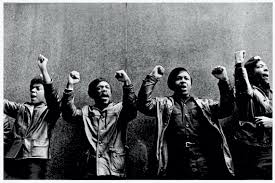
Friday
Attempts to demonize Black Lives Matter take me back to 1968, when the Black Panthers were similarly demonized. Their response to murderous cops was to arm themselves, which was the last time that Republicans supported significant gun control legislation. It also led to some shootouts and to the police assassination of Fred Hampton and a fellow Panther. (Chicago eventually had to pay out $1.85 million to the victims’ families.)
At the time, my father wrote the following poem, which seems only too relevant today. I’m thinking that the poem’s last line refers to the pre-dawn raid on Hampton’s apartment, cued up by the race-obsessed J. Edgar Hoover. The color symbolism in the first refrain may be to Union blue and Confederate gray. White cat claims the purity of the flowering dogwood but is actually “blacker than a cat can be.”
By couching race relations as a sing-song animal ballad, Bates approaches 1960s race issues in a way that is easier to hear and absorb. We appear to be revisiting the era as our current president labels protesters “thugs,” calls for law and order, and targets the Fair Housing Act of 1968. Donald Trump is still “living in a hell of a rage.”
The Black Cat Blues
for the Panthers 1968
By Scott Bates
Black cat’s black as a cat can be
White cat’s whiter than a dogwood tree
Hey hey
Who do you say
Black is blue and white is gray
Black cat’s living in an old cat cage
White cat’s living in a hell of a rage
Hi hi
Mud in your eye
Twenty million black cats baked in a pie
Black cat’s rotting in an old cat jail
White cat’s chasing his fat cat tail
Hey hey
What do you play
Here we go murdering cats in May
Black cat’s fighting for the day he’ll be free
White cat’s blacker than a cat can be
Ho ho
What do you know
Three to get ready and here we goFurther thought: The Black Panthers had a mixed record, doing a fair amount of good (for instance, their children’s breakfast program) but also engaging in some questionable practices. They were locked in a battle with Martin Luther King over the direction of the Civil Rights movement when I heard King speak in 1967. King understood that practicing non-violence stood a better chance of success than brandishing weapons, an insight that history has borne out and that the Black Lives Matter movement shares.

